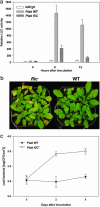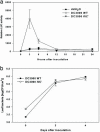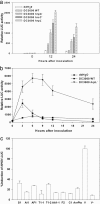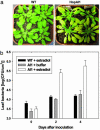Flagellin induces innate immunity in nonhost interactions that is suppressed by Pseudomonas syringae effectors
- PMID: 16123135
- PMCID: PMC1200263
- DOI: 10.1073/pnas.0502425102
Flagellin induces innate immunity in nonhost interactions that is suppressed by Pseudomonas syringae effectors
Abstract
Arabidopsis NONHOST1 (NHO1) is required for limiting the in planta growth of nonhost Pseudomonas bacteria but completely ineffective against the virulent bacterium Pseudomonas syringae pv. tomato DC3000. However, the molecular basis underlying this observation remains unknown. Here we show that NHO1 is transcriptionally activated by flagellin. The nonhost bacterium P. syringae pv. tabaci lacking flagellin is unable to induce NHO1, multiplies much better than does the wild-type bacterium, and causes disease symptoms on Arabidopsis. DC3000 also possesses flagellin that is potent in NHO1 induction, but this induction is rapidly suppressed by DC3000 in a type III secretion system-dependent manner. Direct expression of DC3000 effectors in protoplasts indicated that at least nine effectors, HopS1, HopAI1, HopAF1, HopT1-1, HopT1-2, HopAA1-1, HopF2, HopC1, and AvrPto, are capable of suppressing the flagellin-induced NHO1 expression. One of the effectors, HopAI1, is conserved in both animal and plant bacteria. When expressed in transgenic Arabidopsis plants, HopAI1 promotes growth of the nonpathogenic hrpL- mutant bacteria. In addition, the purified phytotoxin coronatine, a known virulence factor of P. syringae, suppresses the flagellin-induced NHO1 transcription. These results demonstrate that flagellin-induced defenses play an important role in nonhost resistance. A remarkable number of DC3000 virulence factors act in the plant cell by suppressing the species level defenses, and that contributes to the specialization of DC3000 on Arabidopsis.
Figures






Similar articles
-
The Erwinia amylovora avrRpt2EA gene contributes to virulence on pear and AvrRpt2EA is recognized by Arabidopsis RPS2 when expressed in pseudomonas syringae.Mol Plant Microbe Interact. 2006 Jun;19(6):644-54. doi: 10.1094/MPMI-19-0644. Mol Plant Microbe Interact. 2006. PMID: 16776298
-
Effector-triggered and pathogen-associated molecular pattern-triggered immunity differentially contribute to basal resistance to Pseudomonas syringae.Mol Plant Microbe Interact. 2010 Jul;23(7):940-8. doi: 10.1094/MPMI-23-7-0940. Mol Plant Microbe Interact. 2010. PMID: 20521956
-
The Pseudomonas syringae type III effector tyrosine phosphatase HopAO1 suppresses innate immunity in Arabidopsis thaliana.Plant J. 2007 Nov;52(4):658-72. doi: 10.1111/j.1365-313X.2007.03262.x. Epub 2007 Sep 18. Plant J. 2007. PMID: 17877704
-
Suppression of host defense in compatible plant-Pseudomonas syringae interactions.Curr Opin Plant Biol. 2005 Aug;8(4):361-8. doi: 10.1016/j.pbi.2005.05.005. Curr Opin Plant Biol. 2005. PMID: 15936244 Review.
-
Closing the circle on the discovery of genes encoding Hrp regulon members and type III secretion system effectors in the genomes of three model Pseudomonas syringae strains.Mol Plant Microbe Interact. 2006 Nov;19(11):1151-8. doi: 10.1094/MPMI-19-1151. Mol Plant Microbe Interact. 2006. PMID: 17073298 Review.
Cited by
-
Non-host defense response in a novel Arabidopsis-Xanthomonas citri subsp. citri pathosystem.PLoS One. 2012;7(1):e31130. doi: 10.1371/journal.pone.0031130. Epub 2012 Jan 27. PLoS One. 2012. PMID: 22299054 Free PMC article.
-
A Pseudomonas syringae ADP-ribosyltransferase inhibits Arabidopsis mitogen-activated protein kinase kinases.Plant Cell. 2010 Jun;22(6):2033-44. doi: 10.1105/tpc.110.075697. Epub 2010 Jun 22. Plant Cell. 2010. PMID: 20571112 Free PMC article.
-
The majority of the type III effector inventory of Pseudomonas syringae pv. tomato DC3000 can suppress plant immunity.Mol Plant Microbe Interact. 2009 Sep;22(9):1069-80. doi: 10.1094/MPMI-22-9-1069. Mol Plant Microbe Interact. 2009. PMID: 19656042 Free PMC article.
-
2,4-Dihydroxybenzoic Acid, a Novel SA Derivative, Controls Plant Immunity via UGT95B17-Mediated Glucosylation: A Case Study in Camellia Sinensis.Adv Sci (Weinh). 2024 Feb;11(7):e2307051. doi: 10.1002/advs.202307051. Epub 2023 Dec 8. Adv Sci (Weinh). 2024. PMID: 38063804 Free PMC article.
-
Innate immune responses activated in Arabidopsis roots by microbe-associated molecular patterns.Plant Cell. 2010 Mar;22(3):973-90. doi: 10.1105/tpc.109.069658. Epub 2010 Mar 26. Plant Cell. 2010. PMID: 20348432 Free PMC article.
References
-
- Heath, M. C. (1987) Can. J. Plant Pathol. 9, 389-397.
-
- Martin, G. B., Bogdanove, A. J. & Sessa, G. (2003) Annu. Rev. Plant Biol. 54, 23-61. - PubMed
-
- Belkhadir, Y., Subramaniam, R. & Dangl, J. L. (2004) Curr. Opin. Plant Biol. 7, 391-399. - PubMed
-
- Nurnberger, T., Brunner, F., Kemmerling, B. & Piater, L. (2004) Immunol. Rev. 198, 249-266. - PubMed
-
- Felix, G., Duran, J. D., Volko, S. & Boller, T. (1999) Plant J. 18, 265-276. - PubMed
Publication types
MeSH terms
Substances
Associated data
- Actions
LinkOut - more resources
Full Text Sources
Molecular Biology Databases

